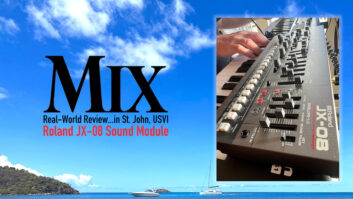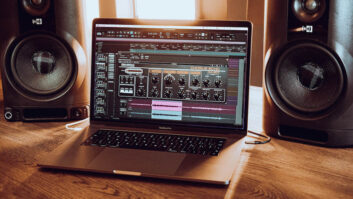So is it a sampler or your favorite loop-based application in abox? People seem a little bit confused about who and what theRoland VP-9000 Variphrase Processor is for, though everyone seemspretty convinced that it’s the next big thing. (It recently scoredan EM Editors’ Choice Award for Most Innovative Product.) TheVP-9000, intended for professional producers, engineers andespecially remixers, delivers the features and creative flexibilitythat we’ve all wished for from our samplers and DAWs.
Though the VP-9000’s pitch, time and formant control featuresare available as separate pieces of software for a fraction of thecost, the Roland unit packs all these features in one box,conveniently behind a few knobs and allows you to audition them inreal time (which no software can presently do). The interface givesusers a quick and creative way of tweaking and remixing elements ofaudio that would normally bog down computers and throw a wrench inthe creative process.
Roland’s advertising pitch of “Elastic Audio” isn’ttoo far off: The VP-9000 allows you to match the tempo of differentsamples and add swing to stiff rhythms, and the unit also providesreal-time, independent pitch, time and formant control. The VP-9000is not, however, an all-purpose sampler; the six-voice polyphony,the loading time and the output architecture do not compare withthe features of the E-mu and Akai units. But the powerful,sample-based processor will allow you to create fresh sound designsthat you can send right to multitrack.
MAIN FEATURES
The in/out architecture clearly speaks to both the professionaland semi-pro recording set. The I/Os include a pair of ¼-inchbalanced inputs (with selectable -20, -10 and +4dBm gain settings);optical and coaxial digital I/Os; three pairs of ¼-inchoutputs; MIDI in/out/thru; a single front panel, ¼-inch,balanced input; SCSI A and B; and a headphone jack.
The front panel is divided into three regions. On the left sideare all the controls for loading and recording samples, includingcontrol knobs for output volume and recording level. In the centeris a larger, amber-colored LCD with a series of function and scrollkeys. On the far right are the time, pitch and formant/groovecontrol knobs, the real meat and potatoes of the unit, plus agenerous complement of onboard effects. The effects are based onthe same algorithms found throughout the Roland/Boss family ofproducts: chorus, reverb, numerous multi-effects and standard LFOfor each sample, and they can be automated. There is also a greatresampling function, which allows you to print effects to anexisting sample and create a new file out of it.
The unit ships with eight MB of installed memory, allowing for amaximum sample length of 25 seconds in stereo (50 seconds mono).The onboard memory can be expanded to a respectable 136 MB (thoughno single sample can be larger than eight MB, even with theupgrade). The memory upgrade is accomplished by simply removing thetop panel of the unit (four screws) and dropping in up to four 32MBSIMMs; in fact, any combination of eight, 16 and 32MB SIMMs willwork. For storage, the VP-9000 includes a 250MB Zip drive; the goodpeople at Roland swear that the infamous and unexplainable“Zip-disk click of death” is a thing of the past, and Ididn’t experience any problems with it. The VP-9000 will also backup to an external hard drive and is capable of burning its ownCD-Rs via SCSI.
GETTING STARTED
Getting audio into the VP-9000 really couldn’t be any easier.Users familiar with Roland’s VS Series of workstations willrecognize the concept of EZ routing, though the VP-9000 uses aslightly different version. Simply press the Sampling key on thefront panel to pop up the sampling screen. Turn the value knob (onthe right) to select the desired input source (front panel mic,analog or digital in), adjust input level, create a name for thefile and you’re rolling. All the settings for source, stereo/mono,original pitch, etc., are also totally straightforward, and theyall appear in the same screen along with the recording level. Fromhere, you have to load or “encode” your new file inorder to audition the unit’s real features. This, unfortunately,takes longer than you’d expect—30 to 40 seconds.
Features associated with the internal metronome allow you to settempo, sample length in bars, click and count off. This can savetime in the sample editing screen (because you’re essentiallypunching in your performance to a click), plus the informationtravels with the file for later use. However, if you fail toproperly label these elements, then you will be unable to syncsamples and swing rhythms accurately. After recording andtruncating a sample in the wave edit screen, change tempo and thesample length, in bars and beats, to reflect the changes.
When encoding a sample, you have three labeling options for thefile: Solo, Backing or Ensemble performance. Following Roland’srecommendations, vocals and lead instruments should be encoded asSolo files, drum and rhythmic phrases as Backing files, andstrings, pads and ambiences as Ensemble. The Solo and Backingformats allow you to apply the formant and groove controls as theywere intended.
PITCH, TIME, FORMANT AND GROOVE
One obvious use of the VP-9000’s pitch control is to produceharmony vocals, which you can control via MIDI from inside yourfavorite DAW without taxing your system. I found that the 50seconds of mono recording time was generally more than enough tothicken up the average vocal phrase. With the VP-9000 set to TimeSync and Polyphonic modes (which allows you to trigger the phrasefrom several keys, at different times, without the phrase startingover or falling out of sync), you can simply create whateverelaborate harmony you like right off the keyboard and thenfine-tune it in a MIDI step editor.
The formant control is also a slick feature. Without affectingthe time or the pitch, you can literally transform vocals fromJames Earl Jones to Alvin of the Chipmunks. The sound does begin toget artificial and otherworldly at either extreme, but that’s notto say it’s unusable. Another interesting feature is the“Robot Voice” function, which removes pitch from avocal phrase, leaving only the base tone. With the unit still inTime Sync mode, you can then “play” a new vocal melody.Again, this can sound less-than-natural, but it didn’t stop me fromcoming up with all sorts of bizarre sounds, and I’ve already begunhearing a number of remixers and dance music producers using thistrick. The catch is that you have to play legato or create just atiny overlap between notes inside your sequencer’s step editor,which I found to be a lot more accurate. It can be tricky in placesto line up the notes of the sequencer with individual syllables andbreaths in the vocal track, but practice makes perfect.
I found the Time control to be dead-on and blissfully easy touse. All you have to do is turn the knob or dial-up a new masterbpm, and you’re there. Nothing could be easier. The unit doesproduce a few pops and hisses with the tempo turned way, way down,but within the 60 to 220bpm range, the results were excellent. TheGroove control, however, failed to impress on a practical level.You’re given the option of adding either an eighth or a 16th noteof swing via a number of templates. But I just didn’t feelcomfortable with the results, even with the simplest 4/4 drum loop.On the other hand, drums ‘n’ bass and other electronicartists might really enjoy some of the unpredictable syncopationand breaks that the Groove function produces. I found it especiallyfun to pitch a two-bar breakbeat way down to the basement octavesand apply the Groove function; the result was a cool elementaltexture that fell in and out of sync with the rest of thetrack.
SYNCHING SAMPLES
The VP-9000 is capable of synching up to six phrases of monoaudio, regardless of their original tempo (the pieces do, ofcourse, have to be in the same time signature). For this to work,the bpm for each piece must be known and entered. If you’re playingor singing into the VP-9000, then this isn’t a problem, because youcan enter that information before you start. If you’re samplingfrom a CD or some other source, then the VP-9000 can identify thebpm of a phrase as long as it’s edited to an identifiable number ofbars and beats. The VP-9000 then forces all the elements to play tothe identified master bpm, which works fairly well. The overallprocess of synching samples is again pretty straightforward, but itcan get tricky in places. Obviously, if you fudge the beginning ofa given sample, then the Sync function is not going to work. Also,if you’re trying to get a couple of samples to loop continuously,then you’ll have to spend some time really fine-tuning your editsso the whole thing doesn’t get thrown off. Otherwise, simplyretriggering the phrases on every bar (assuming the originalsamples were longer than one bar) will keep things moving verysmoothly and very accurately.
CONCLUSIONS
Gripes. I can’t understand why the three control knobs forpitch, time and formant/groove don’t have any sort of correspondingreadout on the LCD. If you follow the procedure for sampling andencoding, then the sample files already carry the appropriate pitchand tempo information. Why isn’t there a little icon following youalong when you turn the pitch knob? A simple display showing thenumber of steps the sample has moved—or the amount that thetempo has changed in % or relative bpm—would be a huge help.And the same applies to the Groove function; you turn the knob toalter the amount of swing, but in relation to what? The sampleeditor should also have a playback scroll marker to make editingand identifying loop points a little easier, though it’s otherwisevery user-friendly; the Zoom function is great. Also noticeablyabsent from the feature set are any filter envelopes, and this isbound to irritate many users. But if you intend to integrate theVP-9000 into a larger studio environment, then this isn’t a bighurdle.
To Roland’s credit, though, the company, just prior to presstime, began shipping the V-Producer software suite for the VP-9000($395 MSRP). The software is compatible with both Mac and PCplatforms and brings to the VP-9000 a greatly enhanced feature setthat deals with many of the issues noted above. Features of noteinclude: “drag-and-drop” sequencing of VP-9000 files;intricate graphic editing and displays for pitch, time and formant;6-channel mixing and effects routing; batch encoding of .WAV and.AIFF files; MIDI clock/MTC sync; and a Song Export mode thatcreates a Standard MIDI file.
So should everyone rush out and buy one? If you are aprofessional remixer or the bulk of your business is loop- andsample-based music (especially hip hop and dance music), then gofor it; the real-time pitch, time and formant controls will justifythe $3,200 MSRP in a matter of weeks. Also, from a sound designperspective, the VP-9000 lets you really mangle audio in new andvery controllable ways. For the rest of us, the Variphrase isobviously the first in a line of products, which speaks of a verybright, not-so-distant future, but the current high price tag andlimited feature set may convince some potential customers to waitfor the next product iteration. Today’s VP-9000 is a great unit,but a costly one.
Roland Corporation U.S., 5100 S. Eastern Ave., Los Angeles, CA90040; www.rolandus.com.
Robert Hanson, Mix’s editorial assistant, is a musician/producerliving in San Francisco.



